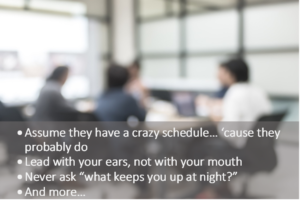 It was 6:45AM on a Wednesday morning at VA headquarters, aka VACO. As Deputy Assistant Secretary for DevOps, I liked to personally greet my vendor guests as they arrived at the front door. Standing in the VA lobby, I winced as I watched visitors struggle through VA’s badging process. 20 minutes later, we were seated in my conference room and this 7AM 30-minute meeting was already 5 minutes behind schedule. A little irritated, I politely asked the vendors how they were doing. By the time the vendor team had finished their introductions and background, roles in their company, discussion about the weather, local restaurants and coffee shop, my executive assistant was rapping on the door giving us the “5-minute warning”. I closed my notebook (signaling the meeting was over) and informed the vendors that I would have someone help them back to the lobby where I had greeted them earlier. I felt bad. But my next meeting was about to begin. Unfortunately, this was a wasted opportunity for all of us, and it did not have to go that way. Here are my suggestions on how to be more productive for everyone…
It was 6:45AM on a Wednesday morning at VA headquarters, aka VACO. As Deputy Assistant Secretary for DevOps, I liked to personally greet my vendor guests as they arrived at the front door. Standing in the VA lobby, I winced as I watched visitors struggle through VA’s badging process. 20 minutes later, we were seated in my conference room and this 7AM 30-minute meeting was already 5 minutes behind schedule. A little irritated, I politely asked the vendors how they were doing. By the time the vendor team had finished their introductions and background, roles in their company, discussion about the weather, local restaurants and coffee shop, my executive assistant was rapping on the door giving us the “5-minute warning”. I closed my notebook (signaling the meeting was over) and informed the vendors that I would have someone help them back to the lobby where I had greeted them earlier. I felt bad. But my next meeting was about to begin. Unfortunately, this was a wasted opportunity for all of us, and it did not have to go that way. Here are my suggestions on how to be more productive for everyone…
Make meetings with VA clients more productive
The Office of Federal Procurement Policy encourages agencies to promote strong communications practices with vendors. But most VA and government employees are unaware of their obligation to learn about market capabilities and the ways that industry may fulfill requirements. Yet it’s common for government employees to avoid meetings with vendors if their calendar that day has been populated with back-to-back meetings or if they’ve been given new pressing assignments with already unrealistic deadlines. And to be frank, some vendor meetings can be overly burdensome (or overly boring, e.g., capabilities briefings).
With that in mind, here are steps I suggested vendors take to ensure a productive meeting when I worked as an executive in VA/OIT.
“Something New” never gets old
Something new is the price of a successful meeting. Educate me about me. Help me discover something about my own problems, gaps, or shortcomings in my area of responsibility. Then offer solutions to those problems by showing me, not telling me.
When working with the OIT/Office of Strategic Sourcing (OSS) Vendor Management Office (ITVMO), you should volunteer to do the legwork to set up the meeting with your target contact. Although ITVMO can be immensely helpful, meeting setup is not really their job. ITVMO’s primary job is to coordinate, deconflict and deduplicate vendor meetings to ensure equitable treatment – not do the legwork and homework for the vendor.
Send an email to your intended meeting contact and cc the Executive Assistant (EA) to set up the meeting to a) confirm the desire to meet, b) provide topics you plan to cover, c) volunteer to take the action to work with the appropriate EAs to work out all the invitations and meeting logistics.
Meeting prep: know your company. Know who you’re meeting with.
When building your briefing: Know the current and past contracts VA holds with your company. Know your problem programs, people, and reputation (because your competition does). Know your most current press releases. Don’t ask “What keeps you awake at night?” To me, that was the same as saying “I did not take the time to learn about your challenges.” Do your homework and propose a solution. If all goes well, have actionable contracting approaches prepared for the question: “How do I get to you?” – (which means: “What contract mechanism do I use to try or buy your product, service or solution?”)
Know the chain of command. In many of my meetings, I spent 15 minutes explaining the org chart of VA/OIT. Since time is precious, you can obviate that time by already knowing your client’s: boss, boss’s boss, people who work for your client (direct reports), admin staff in yo

ur client’s office, and your client’s counterparts in different related agencies, e.g., HHS, DHA, SSA, etc.
Countdown to the meeting: plan and rehearse the meeting ahead of time
Do not wing it. Decide how many of your team should attend the meeting (2, maybe 3, not 4 or more). What will your non-briefing attendees do? Who will keep notes, study body language, collect wall intelligence? (sports, periodicals, etc.)
- 72 hours or earlier prior to the meeting, think about the logistics. If the meeting is in person, dry run your transportation, parking, and visitor control security logistics. Check your ID and PIV cards to make sure none have expired. If the meeting is via videoconference (Teams, Zoom, WebEx, etc.), run a short 2-minute test with the EA.
- 48 hours prior to the scheduled meeting, send an “Executive Briefing Preparation Package” (EBPP template available by requesting at info@federalbiz.com) to the EA, asking the EA a) to confirm all logistics are in place and b) to get the Prep Package to your target contact. That way the EA has 24 hours to get your Prep Package into your intended contact’s nightly take-home read pile.
- 24 hours prior to the briefing. Email the “Executive Briefing Preparation Package” to your target contact It may be redundant, but that’s OK.
- The morning of the meeting. Telephone call the EAs to confirm everything is still on track for the meeting. Confirm that your intended contact received the “Executive Briefing Preparation Package”. Ask the EA “What is our ‘Hard Stop’ time”? Be early – arrive early and leave early. Assume your client has NOT read the read-ahead Prep Package. Ask the client If the meeting agenda is OK and allow the client time to modify it. Assume all your leave-behind material will be seen by your competition. Be respectful to your client and about your competition. Most importantly, use your 2 ears and 1 mouth in that ratio.
After the meeting is over, telephone the EA to express your thanks and ask if there is any immediate follow-up needed. Email the front office staff to thank them. Email and pen & ink a thank you note to the client. Do a hot wash to assess your team’s performance during the meeting (who fell asleep?) Follow up on action items. Then maintain the relationship with periodic updates.
Key takeaways:
- Prepare and help your client be prepared for the meeting
- Educate, listen, and offer solutions
- Positively interact with the client during the meeting

I always tell folks going to VA who do not have a badge to get there at least 30 mins before the start time and while waiting in the security line to contact the escort.
BTW, “Something New” never gets old is such a simple and great motto!
Good stuff Bill!